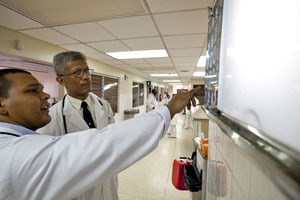Sources of funding
Gifts-in-kind
Significant contributions can be made to health science schools as gifts-in-kind. Important gifts-in-kind can include land on which to site a school, or buildings, or access to buildings (for example, using an apartment block as a dorm). Gifts-in-kind can also come from the community, such as community members allowing students to stay in their homes in the absence of dorms. Other gifts-in-kind may include faculty time and medical and teaching equipment. For example, at the Amoud Medical School in Somaliland, 35% of the faculty teaches as volunteers. Botswana’s first university was founded through the “One man, one beast” campaign, which raised money from the people of Botswana in the form of cash, cattle, grain, eggs and other unique contributions2.
Health insurance funds
A number of countries have health insurance schemes that are run by the public sector, or in partnership with the private sector. A portion of the revenue from the health insurance industry can be allocated to the education of health workers, who will later contribute to the delivery of services for those who are covered by insurance. For example, Medicare in the US provides 34% of the funding for graduate medical education (Braddom 1997).
Local development funds
The community-based medical schools of the Training for Health Equity Network (THEnet) have had success in persuading local governments to use development funds to support the establishment of medical schools. The founding of a new medical school in a district capital or rural town has significant implications for job generation, local health, and educational opportunities. In addition, having a medical school and its associated hospital located in their community makes it easier for local leaders to attract other businesses and professionals. The University of Northern Ontario conducted an analysis of the economic impact of the new school on the city in which it was located, and revealed that the province’s investments had been returned threefold (Northern Ontario School of Medicine 2010). Local development funds can also be used to provide scholarships to local students, with agreements stipulating a required number of years of return service.
Matching funds
Schools can work with large donors to set up matching funds that challenge other donors to make donations. The matching donations may be made by the universities themselves as an incentive for external organizations to make the original contribution (UCSF n.d.). Donors are attracted to matching funds because it allows them to leverage the funding of other donors and effectively double the impact of their money. Matching funds are good at attracting both large and multiple small donations. CapacityPlus is setting up a matching fund with the Methodist Church to help scale up the production of health workers in Methodist health professional schools in Africa.
Microdonations
The relative large sums needed to educate health workers compared to other public health interventions, such as buying a bed net or vaccinating a child, have discouraged small donors. However, through mechanisms such as GlobalGiving.org, minimum donations of $10 are accepted toward the training of a health worker. This taps into a large pool of small donors and facilitates fundraising via campaigns. For example, a single church parish in a developed country can pay for the education of a nurse through microdonations. IntraHealth International set up a program through Global Giving (n.d.) to accept microdonations for the education of health professionals.
Private for-profit investors
Although most private medical and nursing schools are nonprofit, an increasing number are for-profit. Such medical schools tap into the funds available from wealthy investors. One example is St. George’s Medical School in Grenada (SGU n.d.; Smith 1982). This for-profit school was founded by three wealthy investors in 1977. It has now trained more physicians practicing in the US than any other medical school inside or outside the US.
2 Presented at IFC seminar on innovative financing for preservice education, March 31, 2010.

